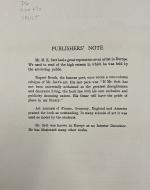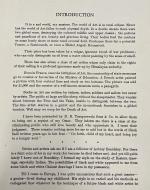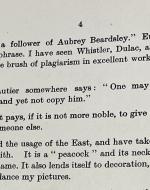Created by Natalie Brown on Wed, 06/07/2023 - 12:31
Description:
In her On Exhibit: Victorians and Their Museums, scholar Barbara Black argues that while Victorian fascination with Rubáiyát can be read as a love for the content of the poem, this fixation and devotion can also be read within the practice of Orientalism, stating that the Rubaiyat has become “one of the age’s most vivid examples of the domesticated exotic” (50). For Black, this practice is apparent in the abundance of ornate gift books of Rubáiyát, as the poem is objectified, and made into a form that further encourages the possession of the work, and the possession of Eastern literature and culture as an extension. Black summarizes this effect in stating: “serving the paradoxical purpose of collectibles, [the Rubáiyát] at once satisfies the possessor’s curiosity for the strange and confirms his superiority” (50). In its dozens of gift book iterations with differing levels of decorum, Khayyám’s Rubáiyát is thus diminished to the status of an obtainable and possessable “treasure book”—collapsed and folded into a Western notion of the East informed by stereotypes that serve to maintain Western dominance (60).
In this illustrated edition of Khayyám’s Rubáiyát, published circa 1946, there lies paratextual evidence of this Orientalist thinking. From the insistence of the illustrator that this edition has potential to restore a fading distinctive upper class, to the regular romanticization of Persian culture as it functions to inform the West, this edition plays into what Black describes as the obsession of possession, pertaining to not just the gift book itself, but to the culture it attempts to depict.
For evidence of this thinking, we first turn to several elements of the front matter. First and foremost, this edition is unique in that there is no prefatory information on Omar Khayyám, Edward Fitzgerald, or any stabilizing context on the origins of the text itself. The front matter, instead, exclusively focuses on the illustrator as seen in the praise of the Publisher’s Notes (see fig. 0), and further inflated through the Introduction. This may be attributed to the fact of Rubáiyát’s popularity and prevalence in culture during this period, allowing for such contextual omissions, but I would argue that in its focus on the accomplishments of the illustrator, it is made clear that this edition’s main focus, and perhaps selling point as a gift book, is based more on the status presumably afforded to those acquiring an object made from a man of prestige and artistry—an argument that is further bolstered by the content of the Introduction itself.
This edition’s Introduction written by the illustrator affords us a clear insight into the intended audience of the gift book, as it starts with a dramatic opening statement that “the world of Art is in total eclipse,” due to the two world wars “destroying the cultured middle and upper classes” —classes that are distinguished as they act as “patrons and guardians of art, beauty and gracious living” (see figs. 1-2). Despite this dismal outlook on the prospects of the art world, there is hope found in this specific edition as Sett explains, “I have been persuaded by D.B. Taraporevala Sons & Co. to allow them to bring out a reprint of my Omar. They inform me there is a class of discriminating public who still love beauty and appreciate it.” In this statement, the meaning of acquiring this edition is not one of simple appreciation of the text itself, but instead places a large importance on the act of ownership, relating to Black’s argument that “possessing the text was as important as reading it, if not more so” (61). In this statement by Sett, by purchasing and possessing this specific edition of Rubáiyát, the collector is enticed to feel as though they are recovering the forlorn status of upper class artistry, and is thus inducted into a role of superiority—they reestablish the role of a “guardian of art.”
It is also noteworthy to point out the possessive language Sett uses to describe this edition of Rubáiyát—he uses the phrase “my Omar;” not simply “my Rubáiyát,” or “my edition,” but a possession of the author himself. In this sense, this edition is embedded with the power of possession and subsequent superiority such ownership affords, as Sett positions himself a kind of informed collector and translator of the poem, supposing that through his interpretation and ownership of Omar Khayyám’s Rubáiyát alone, the crumbling art world can be restored.
Works Cited
Black, Barbara J. On Exhibit: Victorians and Their Museums. United Kingdom, University Press of Virginia, 2000.
Khayyám, Omar. Rubáiyát of Omar Khayyám. Translated by Edward Fitzgerald, illustrated by M.K. Sett, D.B Taraporevala Sons & Co., circa 1946.
Copyright:
Associated Place(s)
Artist:
- M.K. Sett




